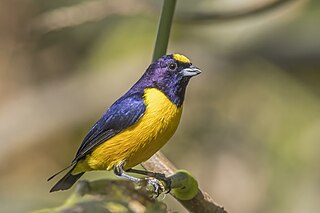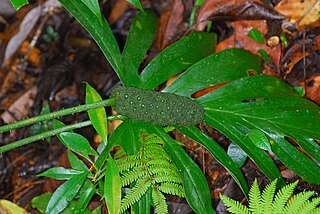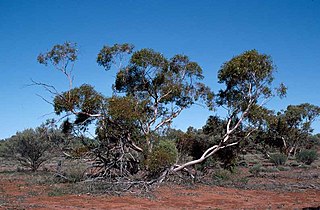Related Research Articles

Pseudemys is a genus of large, herbivorous, freshwater turtles of the eastern United States and adjacent northeast Mexico. They are often referred to as cooters, which stems from kuta, the word for turtle in the Bambara and Malinké languages, brought to America by enslaved people from Africa.

The musk lorikeet is a lorikeet, now the only species in the genus Glossopsitta. It inhabits south-central/eastern Australia. The little lorikeet and the purple-crowned lorikeet were previously included in the genus. The musk lorikeet was first described by ornithologist George Shaw in 1790 as Psittacus concinnus, from a collection in the vicinity of Port Jackson in what is now Sydney. John Latham described it as Psittacus australis. Its specific epithet is the Latin concinna "elegant". Other common names include red-eared lorikeet, and green keet, and formerly a local Sydney indigenous term coolich. The names green leek and king parrot have been incorrectly applied to this species in the past.

The Texas river cooter is a species of freshwater turtle endemic to the U.S. state of Texas. It is found in the river basins of the Brazos, San Bernard, Colorado, Guadalupe, San Antonio, Nueces, and their tributaries. It is one of three species of cooters (Pseudemys) occurring in Texas, including the Rio Grande cooter and the river cooter.

The river cooter is a species of freshwater turtle in the family Emydidae. The species is native to the central and eastern United States, but has been introduced into parts of California, Washington, and British Columbia.

The nabarlek is a small species of macropod found in northern Australia. They are a shy and nocturnal animal that resides in rocky hollows and forages in the surrounding area. Their diet is grasses, sedges, and ferns found in and around their scrub covered refuges. They are distinguished by a reddish tinge to the mostly grey fur and a distinct stripe at the cheek. They move with great speed and agility when observed, with a forward leaning posture and a bushy tail that arches over the back.
Banksia concinna is a species of shrub that is endemic to Western Australia. It has elliptical leaves with between five and twenty triangular teeth on each side, hairy heads of yellow flowers and hairy, egg-shaped fruit.

The elegant imperial pigeon, also known as blue-tailed imperial-pigeon, is a large pigeon, with upperparts mainly dark blue-green in colour with an iridescent sheen. Head, neck and underparts are mostly pale grey, with red-brown undertail coverts.

The velvet-fronted euphonia is a species of bird in the family Fringillidae, having recently been moved there from the Thraupidae.

Hypericum concinnum is a species of flowering plant known as gold-wire or goldwire. It is in the St. John's wort family, Hypericaceae. It is the only species in the section Hypericum sect. Concinna.

The eastern river cooter is a subspecies of turtle native to the eastern United States, with a smaller population in the midwest. It is found in freshwater habitats such as rivers, lakes, and ponds.

Grevillea concinna, commonly known as red combs or elegant grevillea, is a species of flowering plant in the family Proteaceae and is endemic to the south-west of Western Australia. It is a spreading to erect shrub with mostly linear to narrow wedge-shaped leaves sometimes with a sharp point on the tip. Flower colour varies with subspecies.

Lasia is a genus of flowering plants in the family Araceae, native to Asia and New Guinea. The genus contains only two known species, Lasia spinosa and Lasia concinna. Lasia was believed to be a monotypic genus until 1997 when a wild population of Lasia concinna was discovered in a farmer's paddy field in West Kalimantan, Indonesia. The farmer had been growing them for their edible young leaves. This species of Lasia had been known of previously only from a single specimen at the Bogor Botanic Gardens, formally described in 1920. Prior to 1997, the specimen was believed to have been a hybrid between Lasia spinosa and Cyrtosperma merkusii. The subsequent discovery by Hambali and Sizemore led to the realization that it was in fact a distinct species.

Leufroyia concinna is a species of sea snail, a marine gastropod mollusk in the family Raphitomidae.
Rivula concinna is a moth of the family Erebidae first described by Thomas Pennington Lucas in 1895. It lives in Australia in Queensland, Western Australia and the Northern Territory.
Gymnoscelis concinna is a moth in the family Geometridae first described by Charles Swinhoe in 1902. It is found on various Pacific islands, including Tonga, Fiji and the Cook Islands, the Austral Islands, Easter Island, Henderson Island, Pitcairn Island and the Society Islands.

Eucalyptus concinna, commonly known as the Victoria Desert mallee, is a mallee or small tree that is endemic to Australia. It usually has rough, grey-brown on the lower part of its trunk, smooth bark above, lance-shaped adult leaves, flower buds in groups of between seven and eleven, white flowers and cup-shaped fruit. It has a widespread distribution in South Australia and Western Australia, centred on the Great Victoria Desert.
Caladenia concinna, commonly known as the neat spider orchid, is a plant in the orchid family Orchidaceae and is endemic to Australia. It is a ground orchid with a single hairy leaf, and usually a single greenish flower with red stripes on the petals and sepals.

Ebrechtella is a genus of crab spiders that was first described by Friedrich Dahl in 1907.

Parodia concinna, the sun cup, is a species of cactus in the genus Parodia, native to southern Brazil and Uruguay. It has gained the Royal Horticultural Society's Award of Garden Merit.

Myosotis concinna is a species of flowering plant in the family Boraginaceae, endemic to the South Island of New Zealand. Thomas Cheeseman described the species in 1885. Plants of this species of forget-me-not are large, perennial rosettes which form loose tufts or clumps, with ebracteate, erect inflorescences, and yellow corollas.
References
- ↑ BioLib.cz - Elelea concinna. Retrieved on 8 September 2014.